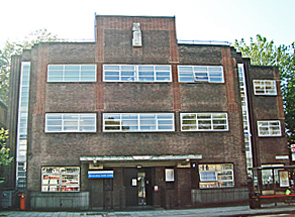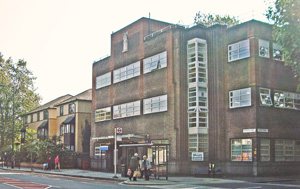American Red Cross
Maternity Hostel
Maternity Hostel
110 Grange Road, Bermondsey, SE1 3BW
Medical
dates:
Medical
character:
Maternity
At the end of WW1 in 1918 there
was almost a complete lack of facilities for expectant working class
mothers in Bermondsey, a very crowded and poor area. Only five
midwives were employed by the Borough Council. Many General
Practitioners had given up dealing with midwifery cases, while Guy's Lying-In Charity covered only about a third of the Borough.
Housing conditions were often insufficient for a mother to be delivered in her own home so, in 1919, the Borough Council decided to establish a lying-in hostel. They were aided in this by the American Red Cross Society, which was providing funds for the setting up of such hostels throughout poor districts of London. The Society donated £2,000 to the National League for Health, Maternity and Child Welfare towards the cost of a maternity home in Bermondsey, which was to be managed by the Borough Council and its medical staff.
A lease was secured on a large vacant house with 12 rooms at No. 110 Grange Road, which was fully equipped as a maternity home at a cost of £874. The two bedrooms on the first floor were converted into one large ward, and the windows in the top floor were enlarged to improve the light. Two bathrooms were provided (one for the patients and one for the staff). Electric lights and bells were installed throughout the building and the rooms were completely redecorated. The drainage was completely overhauled. Special heating apparatus was installed in the basement.
The American Red Cross Maternity Hostel with 12 beds was officially opened on 1st November 1919 by the American Ambassadress, Mrs Davis. The first patient was admitted on 13th November and the first baby born on 19th November.
Within a week of opening, bookings for admission were far in excess of the accommodation for some time to come. Only married women were admitted; each had to pay a minimum of one guinea (£1.05) a week.
On the ground floor, a small room to the right of the front door was used as an office. A large room on the left was the dining room. The back room was divided into two parts, the larger being a ward with 3 beds and the smaller Matron's sitting room.
The largest ward on the first floor contained 6 beds. All the beds were covered with white quilts, which had a red cross in the centre. The cots - of a collapsible type - stood on trestles beside the mothers' beds. They were covered in white canvas, made to be easily slipped off the framework and washed. The babies' mattresses were stuffed with wool and also covered in canvas so they could be washed after use.
The first floor also contained a small labour ward, a bathroom and a WC. The labour ward was adequately and economically fitted. The large sterilizer, of the fish kettle type, was heated by a lamp. The wicker basket to receive the baby was of the fisher creel pattern, and convenient and easy to handle.
The wards were bright and simply furnished, and all looked out onto a large garden at the back. The walls were painted with white enamel paint, which could be washed.
The kitchens and store rooms were located in the basement, and there was a lift to send food to the ward on the first floor. A self-governing hot water circulator ensured a constant supply of hot water, day and night, switching itself off when the water was hot and switching itself on again when the water had begun to cool.
The floors throughout the building had been stained and polished by 'some secret American process' which ensured they would not need polishing again for at least three months.
The staff lived on the top floor of the building, where there were two large and two small bedrooms. The latter were reserved for the Matron and the night nurse, while the two midwives shared one of the large bedrooms and the cook and the housemaid the other. A housemaid and a charwoman were also employed.
In the first full year of its operational life, some 155 cases had been admitted to the Hostel. In the following year, the number was 138 as changes in the Borough began to result in a fall of the number of admissions. Younger doctors replaced some of the older GPs and began to undertake midwifery cases, while the number of midwives practicing in Bermondsey increased from 5 to 10. The cover provided by Guy's Lying-In Charity was extended by the Governors to cover about four-fifths of the Borough. In addition, a large maternity ward had opened at the Bermondsey and Rotherhithe Hospital which, as it was on a larger scale than the Hostel, could charge a lower fee to each patient.
The number of applications for confinement at the Hostel fell from 75 in 1922 to 28 in 1923. Only 66% of the beds were occupied. The total weekly net cost per patient was £7 2s 8d (£7.13), but the Hostel received only an average of £1 14s 4d (£1.72) from each patient. Most stayed for two weeks, so the total loss was £10 16s 8d (£10.83) per fortnight.
Because of these excessive costs, the Borough decided to close the Hostel in 1923.
Housing conditions were often insufficient for a mother to be delivered in her own home so, in 1919, the Borough Council decided to establish a lying-in hostel. They were aided in this by the American Red Cross Society, which was providing funds for the setting up of such hostels throughout poor districts of London. The Society donated £2,000 to the National League for Health, Maternity and Child Welfare towards the cost of a maternity home in Bermondsey, which was to be managed by the Borough Council and its medical staff.
A lease was secured on a large vacant house with 12 rooms at No. 110 Grange Road, which was fully equipped as a maternity home at a cost of £874. The two bedrooms on the first floor were converted into one large ward, and the windows in the top floor were enlarged to improve the light. Two bathrooms were provided (one for the patients and one for the staff). Electric lights and bells were installed throughout the building and the rooms were completely redecorated. The drainage was completely overhauled. Special heating apparatus was installed in the basement.
The American Red Cross Maternity Hostel with 12 beds was officially opened on 1st November 1919 by the American Ambassadress, Mrs Davis. The first patient was admitted on 13th November and the first baby born on 19th November.
Within a week of opening, bookings for admission were far in excess of the accommodation for some time to come. Only married women were admitted; each had to pay a minimum of one guinea (£1.05) a week.
On the ground floor, a small room to the right of the front door was used as an office. A large room on the left was the dining room. The back room was divided into two parts, the larger being a ward with 3 beds and the smaller Matron's sitting room.
The largest ward on the first floor contained 6 beds. All the beds were covered with white quilts, which had a red cross in the centre. The cots - of a collapsible type - stood on trestles beside the mothers' beds. They were covered in white canvas, made to be easily slipped off the framework and washed. The babies' mattresses were stuffed with wool and also covered in canvas so they could be washed after use.
The first floor also contained a small labour ward, a bathroom and a WC. The labour ward was adequately and economically fitted. The large sterilizer, of the fish kettle type, was heated by a lamp. The wicker basket to receive the baby was of the fisher creel pattern, and convenient and easy to handle.
The wards were bright and simply furnished, and all looked out onto a large garden at the back. The walls were painted with white enamel paint, which could be washed.
The kitchens and store rooms were located in the basement, and there was a lift to send food to the ward on the first floor. A self-governing hot water circulator ensured a constant supply of hot water, day and night, switching itself off when the water was hot and switching itself on again when the water had begun to cool.
The floors throughout the building had been stained and polished by 'some secret American process' which ensured they would not need polishing again for at least three months.
The staff lived on the top floor of the building, where there were two large and two small bedrooms. The latter were reserved for the Matron and the night nurse, while the two midwives shared one of the large bedrooms and the cook and the housemaid the other. A housemaid and a charwoman were also employed.
In the first full year of its operational life, some 155 cases had been admitted to the Hostel. In the following year, the number was 138 as changes in the Borough began to result in a fall of the number of admissions. Younger doctors replaced some of the older GPs and began to undertake midwifery cases, while the number of midwives practicing in Bermondsey increased from 5 to 10. The cover provided by Guy's Lying-In Charity was extended by the Governors to cover about four-fifths of the Borough. In addition, a large maternity ward had opened at the Bermondsey and Rotherhithe Hospital which, as it was on a larger scale than the Hostel, could charge a lower fee to each patient.
The number of applications for confinement at the Hostel fell from 75 in 1922 to 28 in 1923. Only 66% of the beds were occupied. The total weekly net cost per patient was £7 2s 8d (£7.13), but the Hostel received only an average of £1 14s 4d (£1.72) from each patient. Most stayed for two weeks, so the total loss was £10 16s 8d (£10.83) per fortnight.
Because of these excessive costs, the Borough decided to close the Hostel in 1923.
Present status (October 2010)
After the Hostel closed, the Council decided to use the building as a Maternity and Child Welfare Centre, to include dental clinics.
The staff of the Hostel moved to Fairby Grange in Hartley, Kent, a property which had been donated to Bermondsey Borough Council in 1922. It was made into a convalescent home for sick mothers and their babies following childbirth. (Fairby Grange was sold in the 1950s and reopened as a residential care home in 1958. It is still operational today.)
At the beginning of the 1930s the Council decided to replace No. 108 Grange Road, used as a TB Dispensary, and No. 110 with a purpose-built health centre.

The Bermondsey Health Centre occupies the sites of Nos. 108 and 110 Grange Road (above and below).

(Author unstated) 1919 The American Red Cross Maternity Hostel. British Journal of Nursing Supplement. The Midwife, 8th November, 291-292.
Connan DM 1956 Annual Report of the Medical Officer of Health. London, Borough of Bermondsey, 9.
King Brown R 1919 Report on the Sanitary Condition of the Borough of Bermondsey. London, Borough of Bermondsey, 21-23.
King Brown R 1925 Report on the Sanitary Condition of the Borough of Bermondsey. London, Borough of Bermondsey, 16-18.
Return to home page